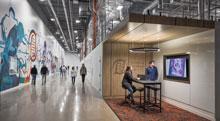
The Next Chapter: Ensuring Relevancy in Today's Academic Library

It’s early afternoon and Mary, a 35-year-old mother and college student who’s pursuing her master’s, soon will be up against her weekly deadline to submit an assignment. She’s had the typically unpredictable “routine” week that only mothers know about, but she’s not panicked. In fact, she’s quite comfortable in the Family Study Room at Central Washington University (CWU) in Ellensburg, Wash., where her 5-year-old son keeps busy by coloring and doing puzzles while she works. Equipped with children’s toys, books, and games for young visitors as well as tables, desks, and chairs for students, the room is the kind of space that Rebecca L. Lubas, dean of library services at CWU, couldn’t have imagined in an academic library when her career began almost 25 years ago.
Nearly 2,300 miles away in Ohio, Sara A. Bushong, dean of university libraries at Bowling Green State University (BGSU), is undertaking a months-long process of uniting the facility’s special collections, a set of four libraries including the Browne Popular Culture Library, the largest collection of American pop culture in the United States. The effort to co-locate these collections is part of an overall master planning redesign at BGSU, where library renovations generally happen annually.
Clearly, these facilities are not examples of the typical stodgy, old libraries, despite both being more than 40 years old. They are not just places of seclusion for those who demand total silence while they read or study, although both facilities offer quiet spaces for those who need it. Instead, these academic libraries have evolved into spaces that provide a variety of amenities to meet the needs of today’s students. The offerings help the libraries remain relevant among the many stakeholders who affect their funding and existence.
The placement of academic libraries—often in the heart of campus—saddles them and their staff with a responsibility to always adapt or risk having their prime real estate overtaken by competing institutional programs that are in more demand. At a time when the average academic library is at greater risk of being undervalued, the libraries at Bowling Green and Central Washington show how such facilities can stretch available funding to make improvements that meet evolving patron demands. They can be proactive in their services and style (or play catch up if need be) as digital technologies and changing student habits affect their functionality and purpose.

A uniquely shaped circulation desk functions as a one-stop service point.
Beyond the Books
The library’s role has expanded beyond acquiring, storing and circulating print material. One important service modern libraries provide is to help students make use of their personal devices and to offer public use of digital devices. Nobody should walk into a library and feel that the use of a desktop or laptop computer, including internet access, is a luxury, Lubas says.
“It’s a basic need for students to complete their education,” she says. “Ideally, students would be able to keep up their own devices throughout an academic year. But you can’t count on that. If you’re having trouble paying your rent, you may have trouble paying for your internet. So, you come to the library for the connectivity that you have by right of registration. Libraries are providing basic needs in a way they probably weren’t 20-25 years ago.”
Other examples of meeting diverse needs include use of therapy dogs for emotional support or having ambient music play in common areas during finals week. Many libraries now allow (or even provide) food and drink.
“In our facility, we provided a popcorn bar and free pizza during finals week,” Lubas says.

A centrally located resource board serves as an innovation catalyst for graduate students and also helps create private meeting space.
Culturally and Collaboratively Connected
Also critical to the success of an academic library is ensuring that the facility aligns with the mission and goals of the institution. At Bowling Green, the philosophy is that the special collections are what make the library unique.
“And so we’re trying to figure out a way to make those spaces and collections more accessible, as well as providing all of the services that we have always offered,” Bushong says.
Bowling Green’s collections include a music library and sound archives, a center for archival collections, and a curriculum resource center (support for preservice teachers in preK through 12).
“Our preferred scenario would be to have all of the collections on one floor with a shared reading room rather than them being siloed on different floors,” Bushong says.
At Central Washington, a public university dependent on state funding, engagement with the greater Ellensburg, Wash., community is a priority for its library, Lubas says. The Cultural Conversations program brings together students and community members for lectures by faculty, staff, and students who were born outside the United States but live in Ellensburg.
“They talk about life in their countries and their experiences,” Lubas says.
Likewise, the Central Washington library partners with the English department to have local writers discuss their diverse backgrounds.
“So, both students and community members get the chance to interact and ask questions about cultures that they’ve maybe only read about previously,” Lubas says.

A transformational master plan sets the future vision for this iconic library.
Focus on Furniture
A core component of the modern campus library is comfortable and versatile furniture. A combination of longer tables, preferably those lengthened with extenders or connectors, smaller tables, and cushioned chairs that feature swiveling arm desks, is recommended. Tables and chairs that have wheels and are easily movable also should be available.
“In collections, you need some bigger tables because people will be spreading out maps and other bigger documents,” Bushong says, “and we’ve found that students don’t like high-top tables because they can’t reach down to get their bags or other items off the floor.”
Power stations for smartphones and other devices need to be built into or close to as much furniture as possible. “Users want power,” Bushong says, “and part of being relevant as a library is that you constantly are trying to improve the space, so it fits what students need.”
Seven Strategies for the Evolving Library
Here are seven strategies to consider when building or renovating campus libraries:
- Develop partnerships such as tutoring centers, career centers, and technology hubs. These types of programs encourage collaboration, promote the library as a “one-stop shop” and will help others to see the library as more than just a place to find a book.
- Foster environments that promote content creation, discovery of new ideas and creativity, such as “makerspaces.” These spaces also promote collaboration and can be varied in style and purpose.
- Track gate counts that reveal who is coming to use the facility. Also, pay attention to who is not using the library and assess whether updating the space could help to draw more people in. Conduct focus groups to better understand how to tailor the library to meet unique needs.
- Use natural light as much as possible, as a well-designed daylighted space can have a positive effect on people’s health and performance.
- Use of natural materials such as wood and stone for new construction will help the library to appear “timeless.”
- Artwork, whether done by students or others, enhances a visitor’s experience and should be incorporated into as many rooms and common spaces as possible.
- Develop inspirational design strategies that reinforce a library’s strategic plan while being compatible with the academic institution’s mission. A disciplined approach could compel administrative leadership to invest in the library, which will help it keep pace with future changes in technology and evolving student needs.
Red Flags to Avoid
To transform underused library spaces, take steps to eliminate:
- Straight-backed wooden chairs. If the furniture is not comfortable, visitors will not spend much time in the library.
- High-top tables and chairs. These can be awkward, especially for students who may put their school bags or other items on the floor and can’t reach them from the tabletop.
- Too many books in one space may not be inviting. Organize the book stacks logically to encourage the browsing experience. Consider prominently featuring new books and those associated with unique academic programs, such as a special topic being taught by a visiting scholar, to dynamically manage the print collection.
- Don’t let quiet space dominate collaborative space. Students should be able to find places to study quietly, but an environment that promotes collaboration as a priority is more appropriate for modern libraries. Strike the right balance of silent and group study, along with “alone together” spaces.
This article was originally published in American School & University magazine.
Author
Content Type
Published Articles
Date
August 01, 2019
Market
Topic
Library Design



